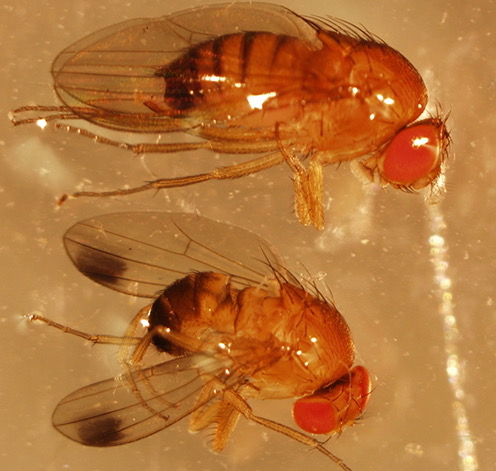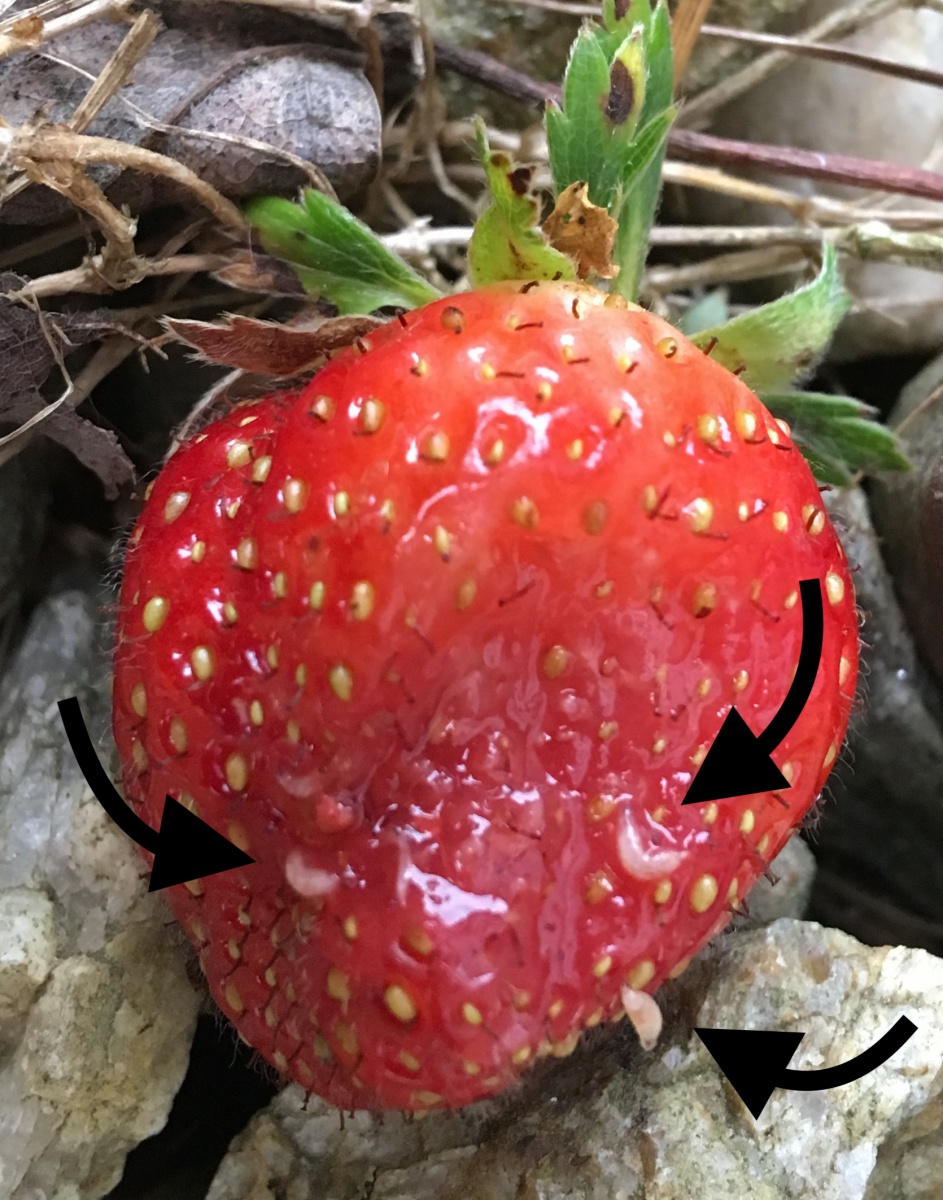Spotted Wing Drosophila (SWD) is a vinegar gnat from China and Japan. It attacks ripening and ripe fruit of brambles (raspberry & blackberry), strawberry, blueberry, grape, cherry, plum and peach, plus many species of wild berries. We first discovered it in New Hampshire on September 6, 2011. In 2012, SWD caused over $1.5 million in crop losses in NH. The insect looks similar to our other 39 species of drosophilids (e.g. fruit flies): tiny, 2mm long (about 1/12 inch) flies attracted to the odor of fruits and/or fermentation and vinegar. It attacks ripening and ripe fruit, while our other drosophilids attack overripe or rotting fruit. The SWD females lay eggs INSIDE ripening fruit, so if you do not monitor your vulnerable crops, they could be infested with larvae inside.

The males are easy to identify by their spotted wings.
If you wish to keep your fruit from becoming infested, it is critical to monitor the insect with traps. When the flies appear and your crop is ripening, an insecticide spray can prevent it from being infested.
Timing of SWD appearance & attack
In general, SWD survives the winter, but adult flies are not detected in traps in NH until early July. The exact timing varies from year to year. In 2017, for example, SWD was detected earlier than normal throughout New England, and potentially damaging numbers of SWD were present in traps located in cherry, raspberry, and blueberry crops, as well as the latest June-bearing varieties of strawberry.
Find weekly reports on SWD activity in your area here.
Growers intending to manage this pest should set up their own traps. By monitoring SWD traps, growers make effective decisions about when they need to make insecticide applications.
Directions for making an SWD trap (plus lots of other good information) are available in the resource entitled “Monitoring spotted wing drosophila with traps”. However, effective commercial traps, lures, and baits are now available. These traps are reusable, and are available from standard suppliers of IPM products.
Testing Fruit for Presence of SWD Larvae
If you suspect that your fruit plantings may be infested with SWD, there are straightforward ways to check the fruit for the presence of larvae.
- Collect intact fully ripe fruit. Avoid decomposing fruit, which may contain larvae of other fruit flies.
- Add a salt solution (1/4 cup salt to 4 cups water).
The SWD larvae float in this solution. The larvae are white, and about 1/8 inch long when full-grown.

Controlling SWD in crops
There are both cultural and chemical strategies to prevent infestation by SWD. Growers that use both in combination are likely to have the best chances of success.
Non-chemical controls
Destroy Nearby SWD Hosts: Several growers noted heavy SWD attack on fruit that had pokeweed nearby. Ripe pokeweed fruit are known important SWD hosts, so If your crops mature after pokeweed fruit (Aug 15 to Sept 15) eliminating the pokeweed plants can lower the risk of heavy attack on your crops. The same is true for glossy buckthorn, which has ripe fruit Aug 6 to Sept 15.
Research on the importance of honeysuckle fruit varies. In some studies in the Northeast, it appeared to be an important host. Fruit sampling and rearing conducted by extension personal suggested it is not as important as as pokeweed or glossy buckthorn. Kousa dogwood fruit are important hosts, but they are ripe so late in the year, they should not affect SWD attack on crops. Deadly nightshade fruit do not appear to be significant SWD hosts.
Pruning: SWD adults seem to prefer relatively high humidity, leaf cover and shade. Dense canopies are perfect for heavy attack. Pruning to open up the canopy makes it less favorable for the adults, and also allow better spray penetration to the interior of the crop.
Variety Selection: In general, early-ripening varieties experience less SWD infestation than late varieties. We have some evidence that suggests some white peaches are especially prone to attack. In grapes, colored, thin-skinned varieties seem to be attacked more that tougher-skinned or green (“white”) grapes. We do not have enough experience with plums, currants or cranberries to evaluate varietal differences.
Destroy Damaged Fruit: If feasible, pick and destroy fruit that appear damaged to reduce the chance of SWD buildup. To destroy them, either freeze and then dispose of them, or deeply bury and cover them. Simply dumping them does not kill the immature larvae in the fruit.
Netting: If you can completely enclose your crop in netting with openings no larger than 0.9mm, SWD adults cannot get inside. One problem is setting up a door to allow repeated entry for picking, yet not allow the flies to get in. Note that netting the crop with mesh this fine will increase the temperature and relative humidity inside.
Post-Harvest Refrigeration: Cool temperatures stop the development of small life stage before they grow into visually observable forms. Prolonged cold storage can also kill young life stages (e.g. three days in a normal refrigerator).
Freezing: Freezing the fruit kills any eggs or larvae that might be inside, but alters the fruit characteristics.
Chemical controls
Since this is a new pest, management options are somewhat limited, and are changing rapidly. Other good resources for SWD information include The New England Small Fruit Management Guide, Michigan State University’s SWD Page, and the University of Maine’s SWD Blog.
